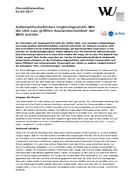Foreign trade imbalance: How the USA has racked up the world’s largest foreign debt
Starting from the late 1980s, the USA has moved from being a net creditor to having the world’s highest foreign debt. In the period from 2006 to 2014, the USA’s foreign liabilities came in at an average of 23% of the gross domestic product. A study conducted by Katrin Rabitsch from WU’s Institute for International Economics and Development poses the question of whether this makes the US inherently dangerous. Her results show that part of the USA’s foreign debt can be explained by structural differences: Because of its well-developed financial market and its high level of openness to international financial markets, the US has less motivation to hold assets, as compared to other countries.
Today, the states of national economies are strongly interconnected both through foreign trade in goods and through international asset trading. The past few decades have seen an unprecedented surge in international capital market integration, during which the USA has incurred the world’s highest foreign debt. The US’ net foreign asset position is calculated based on the balance between financial assets held by US investors abroad and financial assets held in the US by non-US investors. Currently, this balance is negative. This means that the USA has more foreign liabilities than receivables, making the country a net debtor. The country’s major creditors include China and Japan as well as other Asian emerging nations. Contrary to theory “The commodities trade has grown considerably over the last 30 years, but financial trading has grown by about eight times as much,” explains WU researcher Katrin Rabitsch. She and her colleagues at WU’s Institute for International Economics and Development have observed that external imbalances have increased over the past few decades, meaning that a number of countries have long-standing foreign debts. “At first glance, the fact that the US has incurred the world’s largest foreign debt appears surprising, based on standard economic theories. According to theory, poorer countries are usually in debt to more prosperous nations, to finance their economic progress and help them catch up, rather than the other way around,” she continues.
Structural explanation
This development is not automatically grounds for concern, according to Rabitsch. “Our models show that part of the USA’s external imbalance can be explained on a structural level and does not necessarily imply the threat of instability. A better developed financial market and simpler access to international financial markets give the US better risk coverage. Countries without this option can only counter the risk of a bad year by holding assets in reserve, to have them on hand for bad times.” Countries with underdeveloped financial markets or countries that opened themselves to the international capital market relatively late have a higher motivation to hold assets in reserve as compared to the US. According to the study, these countries are more likely to be net savers, i.e. more likely to be creditors to the US, while the US is more likely to be in debt to the rest of the world. The argument that developed countries are better able to cover their risks may be one of the reasons why the data indicates that developed countries, especially the US, are more likely to invest their foreign assets in high-risk assets than developing or emerging nations.
The big picture
International financial trading has increased so rapidly in today’s economy that there are constantly new developments to understand, and economic theory often lags behind. The USA’s high level of foreign debt remains under critical observation, particularly because it has grown even more in the last few years, reaching a level of -41.6% of the US gross domestic product in 2016 (Bureau of Economic Analysis, preliminary estimate, 3rd quarter of 2016). According to Rabitsch, this means that researchers need to continue to work to understand these constant changes, so that they can assess the inherent risk of instability to the international financial system. She says, “It is important to start getting a grasp of these developments as a system. The most recent economic crisis showed clearly that it’s not enough that individual institutions are found to be in good working order, but rather that everything is part of a system. The same thing applies to the international finance system.”

Katrin Rabitsch is an assistant professor at WU’s Institute for International Economics and Development. She earned her PhD in economics at the European University Institute in Florence in 2008. Her research focuses mainly on international macroeconomics and monetary foreign trade, economic cycles, monetary theory and policy, and financial market frictions in macroeconomics. She has published in numerous internationally renowned academic journals, including the Journal of International Economics and the Journal of Money, Credit and Banking, and also acts as a peer reviewer for journals. From 2014 to 2016, she headed an EU-funded project at WU, entitled 'FinMaP: Financial Distortions and Macroeconomic Performance'. She was awarded her venia docendi (habilitation) in the fall of 2016. Katrin Rabisch is also the recipient of two WU Best Paper Awards. For more information about Katrin Rabitsch, his research and his publications please see our research data base FIDES.
Contact:
Anna Maria Schwendinger
Management
mobil: + 43-1-31336-5478
e-Mail: anna.schwendinger@wu.ac.at

